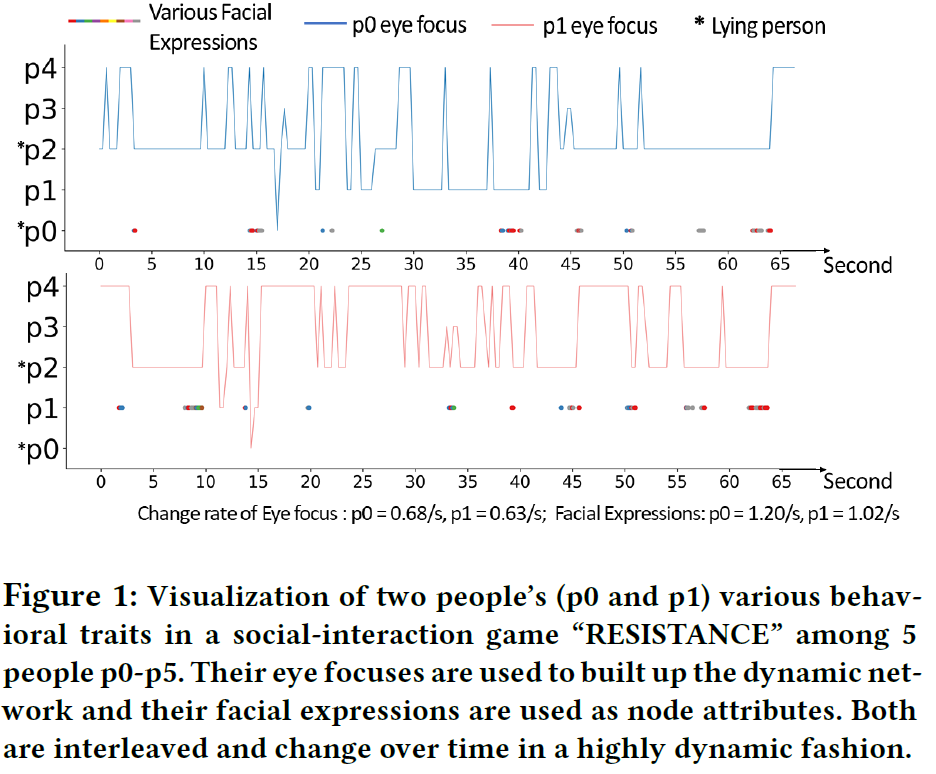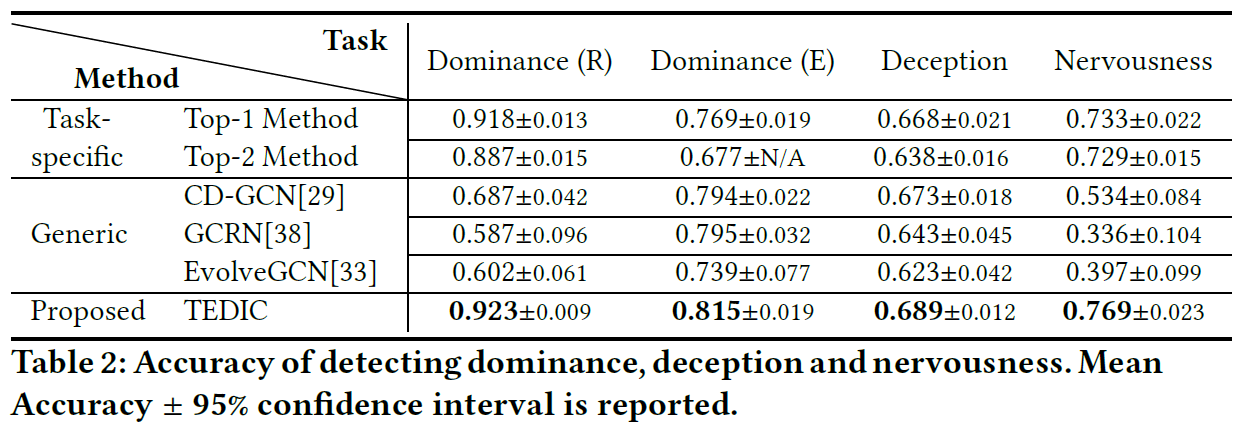TEDIC: Neural Modeling of Behavioral Patterns in Dynamic Social Interaction Networks
We introduce TEmporal Network-DIffusion Convolutional Networks (TEDIC), to learn node representations of dynamic social interaction networks. TEDIC adopts diffusion of node attributes over a combination of the original network and its complement to capture long-hop interactive patterns embedded in the behaviors of people making or avoiding contact. It also leverages temporal convolution networks with hierarchical set-pooling operation to flexibly extract patterns from different-length interactions scattered over a long time span. The design also endows TEDIC with certain self-explaining power. We evaluate TEDIC over five real datasets for four different social character prediction tasks including deception detection, dominance identification, nervousness detection and community detection. TEDIC not only consistently outperforms previous SOTA's, but also provides two important pieces of social insight. In addition, it exhibits favorable societal characteristics by remaining unbiased to people from different regions.
Motivation
Dynamic social interaction networks are an important abstraction to model time-stamped social interactions such as eye contact, speaking and listening between people. These networks typically contain informative while subtle patterns that reflect people's social characters and relationship, and therefore attract the attentions of a lot of social scientists and computer scientists. Previous approaches on extracting those patterns primarily rely on sophisticated expert knowledge of psychology and social science, and the obtained features are often overly task-specific.
More generic models based on representation learning of dynamic networks may be applied, but the unique properties of social interactions cause severe model mismatch and degenerate the quality of the obtained representations. More concretely, dynamic social interaction networks consist of two components that distinguish themselves from the relationship-based social networks arising typically from social media: 1) Highly dynamic attributes of individuals when they make contact, such as facial expressions, gestures and sounds; 2) Complicated and various ways of interactions, such as gazing, speaking and listening. Indicative features often come from the subtle interweaving of them and are concealed in a long-term com-plex interaction background. For instance, previous study found that a lying person tends to quickly switch the eye contacts among different people due to low confidence, but such combination of behaviors may appear only a few times in a long conversation among a large group of people. As a more concrete example, we visualize below the dynamics of people’s behavior sampled from a person-to-person social-interaction game “RESISTANCE” (one of the datasets used in our experiments)

Method
we propose a neural network based model, TEmporal Network-DIffusion Convolutional Networks (TEDIC), to learn node representations of dynamic social interaction networks in a rather general manner, which fits into various node-level prediction tasks.

The first part of TEDIC is network diffusion of node attributes that naturally captures the interweaving between highly dynamic node attributes and interactions. Note that graph diffusion procedure works in some sense similar to graph convolutional networks (GCN) but without using non-linear activation neurons. This simplification allows tracking the effects of long-hop interactions and also improves the model’s explaining power.
The second part of TEDIC is a temporal convolutional network (TCN) accompanied with set pooling to aggregate representations of nodes over a long time span. Due to the locality of temporal convolution kernels, TCN is able to extract patterns from interactions with various durations as these interactions may appear alternatively across multiple consecutive snapshots, and set-pooling is useful to collect subtle patterns scattered over a long-time span. Moreover, TEDIC is end-to-end trainable, and therefore provides an opportunity for social scientists to automatically process dynamic social interactions and obtain insights from the data simultaneously.
Experiment
We evaluate TEDIC over four different node-level prediction tasks, including identification of people’s dominance, nervousness, lying behavior, as well as underlying community, on five different real social interaction networks. From the perspective of making inference, TEDIC significantly outperforms previous baselines that are either based on feature engineering designed for certain tasks or on neural networks for generic dynamic networks.

We further analyze TEDIC's explaining power and broader societal implication by examining its learned coefficients and hidden embeddings
Code & Datasets
A reference PyTorch implementation of the TEDIC framework will be released soon. We provide links to the two public datasets used in the paper: ELEA, CIAWPaper
The paper receives unanimous acceptance from WWW'21. Its preprint can be downloaded from here.Contributors
The following people contributed to the paper:
Yanbang Wang
Pan Li
Chongyang Bai
Jure Leskovec
References



